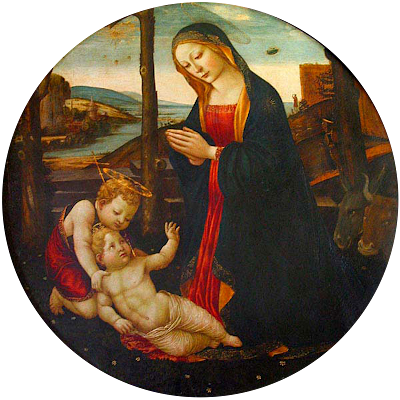The Madonna with Saint Giovannino (The Madonna and Child with the infant St. John) by Domenico Ghirlandaio (Domenico di Tommaso di Currado di Doffo Bigordi 1449 - 1494), on display in the Sala d'Ercole in Palazzo Vecchio, Florence, Italy.
More about this image and story at Public Domain Clip Art - http://publicdomainclip-art.blogspot.com/search/label/Ancient%20Aliens
Domenico Ghirlandaio, whose family name was Bigordi, was born at Florence in 1449, and died there in 1494. We have seen that the Florentine school developed in several directions, but in Ghirlandaio we meet with a remarkable union of the various tendencies it had taken. He was brought up as a goldsmith, and afterwards became a pupil of Alesso Baldovinctti, principally as a worker in mosaic, but he was fully alive to the merits of all his great predecessors among the Florentines, ancient and modern. We see from his works that he was acquainted with those of Giotto, and he made ;i special study of Masaccio whom he followed as a painter of fresco.
The first we hear of his employment as an artist is in 1475, when, on the 28th of November, he began a painting in the Vatican Library, and we find at the same time records of payments to his brother David for work done at the same place down to May 1476 All that is now left of Ghirlandaio's work in Rome is a picture in the Sistine painted then or later—the Call of SS. Peter and Andrew. The composition is well co-ordinated, the principal group is sufficiently conspicuous, the landscape and episodes picturesque, and the perspective thoroughly understood; the colouring is harsher than usual in a Florentine, but for simplicity and clearness the picture is one of the best in the chapel.
This was followed by a still more important work, the decoration of the chapel of the Sassctti family in Santa Trinita, signed and dated 5th December 1485. At the sides of the altar kneel the donor Francesco Sassctti and Nera his wife. Italian art had at this date produced nothing that so nearly approaches the figures of the donors in the great Ghent altarpiece; nor is it in technique only, but in the dignity of realism that Ghirlandaio comes near to the Flemish painters. On the three walls are frescoes of scenes from the life of S. Francis of Assisi—his parting from his father, the founding of the order, the ordeal by fire, the reception of the stigmata, the raising of a dead child, and the death of the saint. We see that Giotto's work in S. Croce had made its mark on the younger painter, but he has translated him into the newer style. The action is carried on with calm simplicity, the heads have all the character of portraits—indeed some of the most distinguished sons of Florence figure in the second subject—and the scenes are set amid views of Florence itself. In the last of the series an impressive contrast is marked between the lamenting brethren who kiss the Saint's feet and hands and the ceremonial gravity of the priests, at their head the abbot with his glasses on his nose; in treatment, drawing, and modelling Ghirlandaio excels every fresco-painter since Masaccio, and on these walls he shows a marked advance on all his former works in colour and technique. In the frescoes in the Chapel of S. Fina at S. Gimignano the ceiling and arches are filled with figures; on the walls are the Mass of S. Gregory and the death of that saint,—in all essential details a repetition of that of S. Francis.
This IMAGE (or other media file) is in the public domain because its copyright has expired.This applies to the United States, where Works published prior to 1978 were copyright protected for a maximum of 75 years. See Circular 1 "COPYRIGHT BASICS" PDF from the U.S. Copyright Office. Works published before 1923 (in this case Circa 1481) are now in the public domain.
This file is also in the public domain in countries that figure copyright from the date of death of the artist (post mortem auctoris) in this case Domenico Ghirlandaio (c. 1449 – c. 1494), and that most commonly runs for a period of 50 to 70 years from December 31st of that year.
TEXT CREDIT: History of Ancient, Early Christian, and Mediaeval Painting, Volume 2, By Alfred Friedrich Gottfried Albert Woltmann, Karl Woermann
















No comments:
Post a Comment